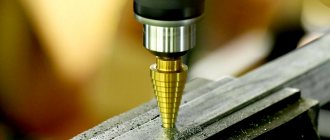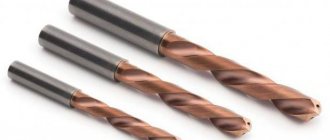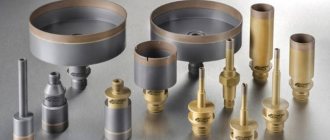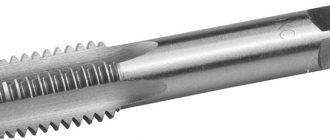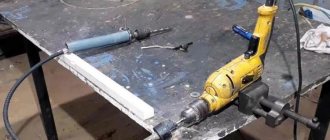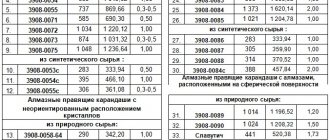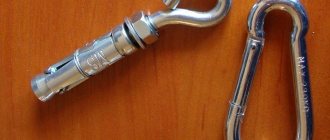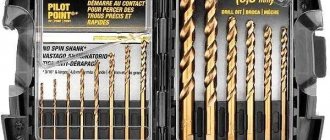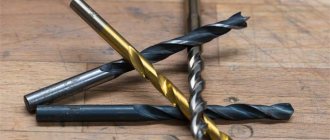Required Tools
Professional metal drills (for example, Bosch, Makita, Metabo or Hawera) are made exclusively from high-speed steel HSS. Some are coated with a protective layer, which increases their wear resistance when drilling.
Hand tools - drills and drill bits should be selected carefully. If you have no experience in this area, you should seek advice from a store employee. Purchasing an expensive, high-end drill does not always guarantee its long service life.
Compliance with the technology for making holes in metal and a correctly selected drill significantly increases its service life and protects against premature wear. Basic rules for operating cutting tools:
- Selecting the appropriate type of gimlet for drilling metal of a certain hardness. Many manufacturers have developed entire programs using which you can select the appropriate tool.
- Selecting cutting modes, setting the correct rotation speed.
- Correctly selected feed, application of appropriate pressure on the cutting tool.
- Application of cooling. An oil-based emulsion is recommended.
- Proper fastening of the material (for example, in a vice).
- Attaching the drill to the stand is precise and perpendicular.
- Use of an expanded set of gaskets when drilling through holes.
Technological process
Drilling is the process of removing small parts of the material being processed, chips, using a drill. During drilling, the temperature of the workpiece increases. The cutting force leads to damage, the friction force causes a change in the geometry of the cutting edge, plus high temperature, as a result the tool gradually becomes dull.
Most drills are made from high-speed steel with varying cobalt content. It is very important that it is sharpened correctly: the cutting edges are of equal length, the jumper between them is located along the axis of the cutting tool.
This ensures that both edges will perform identical work during the drilling process. The drill will not have runout, the hole diameter will correspond to the size, and heating of the part and the tool will be minimized.
A drill-drill with chamfer correction has a smaller jumper, due to this the cutting edges are lengthened. With such drills you can drill a hole without preliminary marking with a core.
The choice of drills depends on the type of work being performed . NWKa HSS Baildon drills are optimal for drilling:
- structural steel;
- cast iron;
- brass;
- bronze;
- aluminum;
- plastics;
- tree.
Drilling metal
A special feature of the drills is the presence of a sharp edge, which allows for mechanical processing of the material. They have an equal diameter along the entire length, and the blade is sharpened at an angle of 118°. The sharpening angle varies depending on the hardness of the material, for example, for alloy steel, it is 135°. This type of drill is made of HSS steel with 5% cobalt. During operation, they require cooling with special drilling oil .
In order to drill a nozzle in metal evenly and accurately, it is necessary to use a guide device - a jig.
When drilling, it is best to use as little force as possible. When drilling a through hole, when the moment of exit of the cutting tool approaches, it is necessary to reduce the feed so that the part does not tear out, the drill does not break, or burrs do not form.
A conical drill is used to produce a conical hole in metal. It is used as an independent tool. They can drill a cylindrical hole, turning it into a conical one. A conical hole in the metal is made on a lathe in order to drill and bore the resulting nozzle with a cutter.
Cutting modes
The most common mistake is using too high a drilling speed . The more difficult the material to process, the lower the drilling speed should be used. For example, in the case of drilling an 8 mm hole in brass, the drilling speed should be 2500 rpm, for harder alloy steel - 800 rpm. The best sign that the drilling speed is correct is nice, long chips.
Depending on which tool to choose, cutting parameters are important. It is necessary to select the correct rotation speed and feed. Bench-top drilling machines provide the best parameters, but they cannot be used everywhere. It is necessary to follow the principle: the lower the speed and the lower the feed, the longer the tool will last.
For example, take stainless steel, 8mm hole, 4mm thickness, cooling lotion or oil, HSS drill bit, drill or drilling machine: The revolutions should not exceed 400 rpm, and the feed should not be more than 0.10 mm/ turnover In other words, you can drill at a speed no higher than 400 rpm. But this speed is not optimal. Therefore, it would be optimal, for example: 170 rpm, and the feed for every 30 revolutions is 1 mm (three times less than recommended).
Cooling the drill during the drilling process is very important. Use emulsions, oils, drilling sprays. Water should be avoided, as it does not have the properties of lubricating fluids, but only cools.
Large diameter holes
To the question of how to drill a large diameter hole in metal, there is only one answer: in the technological process of drilling necks . For example, you need to increase the neck and get a size of thirty millimeters in diameter. First, it is drilled with a tool of a smaller diameter, for example, four millimeters, then to a size of 8 millimeters, then 12 millimeters, and so each size is expanded to the result.
A large diameter neck in a product can be made on a lathe. The operation is as follows: drilling a hole, boring the neck of the desired size. As pre-drilling is required, the process can be divided into stages: small-diameter drilling, reaming with a gradual increase in drill diameter.
Drilling thin sheet metal
The peculiarity of obtaining an armhole in a thin sheet of metal is its reliable fastening . After the drill comes out to the other side, there is a danger that the sheet may suddenly jam and tear out if it was held in your hands. The best way to securely fasten a sheet is a clamp. In this case, the risk that the tin will be torn out is much less. The number of burrs formed is reduced, which will greatly facilitate the finishing of the element.
Read also: How to connect an angle grinder to a battery
If the metal is 0.1 millimeter thick, you can make a hole without a drill by using a metal punching tool. Its design is very simple, like pliers. A punch is attached to one lever, and a matrix to the other. The principle is the same as cold stitching using a stamp.
To cut a through groove in sheet steel, you need to drill a successive row of holes according to size, connecting them into a single slot using a chisel and hammer. To do this, it is necessary to cut off the bridges between the holes and smooth out the unevenness with a file.
Metal pipes
When drilling a metal pipe, make sure that the workpiece is securely secured in the vise. It is advisable to mount the drill on a vertical stand. Insert a piece of wood of the same shape and size inside the pipe, which will protect the pipe from deformation. In this case, use low feed.
Getting narrow nozzles
Drilling deep holes of small diameter can only be done on a special machine or lathe using a device. The part is clamped into a 3-jaw chuck and checked for runout with an indicator. The device is mounted on a tool holder. A drill chuck with a drill is installed in the fixture. First, the hole is centered, then the nozzle is drilled to a given depth. Using a tailstock is problematic, since it needs to be constantly removed to remove chips and lubricant.
To obtain vertical holes, a right angle drilling device is used. For an electric drill, this is a vertical stand at an angle of 90 degrees to the base. The easiest way is to use a vertical drilling machine.
The working area of a cone drill (also known as a “step drill”) is a spiral-shaped recess with several annular transitions of different radii. This device, due to such design features, makes it possible to determine at any stage of processing what size the hole is.
At first it seems that the use of conical step drills, which are characterized by an increased price, is inappropriate, since it is always possible to take a drilling tool of a specific radius and use it to make the desired hole. However, they have some advantages that make their use worthwhile in a variety of situations.
Types of Step Drills Available for Sale
For the manufacture of cone tools, high-speed steel HSS (High Speed Steel) is used. The types of additional processing of the material and surface can be judged by the color of the metal :
A thin layer of abrasive material made from artificial diamonds or titanium alloys can be applied to the surface of the drill. Such processing does not contradict the requirements of the standards and significantly increases wear resistance.
Step drill in action, video
Existing shapes and sizes
There are three forms of cones : a regular stepped one, in the form of a truncated figure without a guide point, and a figure made up of two conical parts with different angles of inclination of the surface.
Shanks for mounting in the chuck can be cylindrical, triangular or hexagonal. The last two types eliminate rotation, but create the risk of injury when the drill jams in the material being processed. However, with sheet thickness up to 4 mm this usually does not happen.
When choosing a tool, you need to pay attention to the size of the starting and finishing diameters. The first size starts from 4 mm or 7/8”, the latter maximum can reach 38 mm. The successive step steps up to 12 mm are every 1 mm, and after that every 2 mm. The usual step height is 5 mm, but can be found at 3, 4 and 6 mm. The value of this size determines the maximum permissible thickness of the material intended for processing.
Number and shape of working grooves
The number of cutting edges is determined by the number of grooves (not to be confused with steps), which can be from one to three. The shape of the grooves is longitudinal straight or spiral. Experts say that the spiral shape increases the service life of the tool, but makes the sharpening process very difficult. Step drills with three flutes are designed to work at high speeds, and with one recess the processing speed must be reduced.
The quality of metal processing at low speeds also depends on the number of grooves.
Stepper drill markings
A high-quality branded tool is always marked with an alphanumeric designation, which indicates:
For example, the inscription Ǿ 4-24/2 HSS-Co 72 says that the first diameter is 4 mm, the last 24 mm, the sequential step of sizes is 2 mm (4, 6, 8 ... 20, 22, 24 mm), made of high-speed steel with the addition of cobalt, Rockwell hardness 56 mm.
In addition, the marking may additionally contain data on the accuracy class and the manufacturer's trademark.
Pros and cons of using step drills
| Advantages | Flaws |
| replacing several drills with one universal drill with different diameters | high price |
| high quality drilled holes | complex sharpening technology |
| possibility of processing thin sheet materials | a cone drill has a conditional accuracy of hole diameter |
| drilling at high drive speeds | |
| reliability and durability | |
| short length, creating more comfortable working conditions | |
| savings on purchasing a complete set of drills |
The most famous manufacturers and prices
A brand very often speaks not only about the quality of products, but also seriously affects their cost. Well-known Western manufacturers guarantee the reliability of their products, but the price of their drills is much higher than domestically produced tools.
Cheap doesn't mean bad ! Among the popular Russian brands producing high-quality stepped cones, the trademarks “Ataka” (ATAKA) and “ZUBR” should be noted. Among the Ukrainian products, Globus conical drills are in demand. The manufacturing level of this instrument is not much different from its European counterparts, but the price can be 2-3 times lower.
The most famous European manufacturers of cone drilling tools are the following brands:
*I would like to point out that the figures may have changed since the publication of the article, so they are given for comparison purposes only.
For a more complete review of popular manufacturers, see here .
The same should be called the American brand MILWAUKEE and the Japanese Yato. You can hear only good reviews about their products, and if not for the high cost, then drills from these brands can be universally recommended for wide use.
Chinese products are distinguished by high manufacturing precision, but the quality of metals leaves much to be desired. Tools from the Middle Kingdom are most often short-lived, quickly dull and wear out; you can find a full range of tools on the most popular website for such products, aliexpress.
Video review of a tool purchased on this site
How to make the right choice
The purchase of a step drill should be based on an accurate formulation of the technological problems that must be solved when using it. Therefore, when choosing, take into account :
As already mentioned, the brand also determines the quality, but in this matter you need to independently choose the best option for the ratio of price and reliability of the tool. See a review of popular manufacturers here .
When purchasing tapered step drills, you will be drawn to a very wide range of prices. For example, products made in Russia and Ukraine with a final diameter of up to 20 mm cost an average of 400-500 rubles per piece, and with a final size of 30 mm or more they are sold 2-2.5 times more expensive.
Tools from well-known foreign brands up to 20 mm are sold for no less than 3,000 rubles, and with a finishing diameter of 30 mm for 5,000-7,000 rubles. Therefore, many buyers prefer to buy two or three drills from a domestic manufacturer rather than pay for one foreign product.
Scope of use, design
Conical drills have a long service life. This is due to high-strength cutting edges. The stepped tool makes it possible to carry out processing for which it would be necessary to use several ordinary drills. The high price of instruments in this group is mainly due to their versatility.
Twist drills with a conical shank make it possible to process parts at high speed. At the same time, the quality of the edge does not decrease at all. The product consists of the following elements:
- tip for preparatory drilling;
- transition with a bevel to eliminate burrs;
- cutting edge that widens the holes.
With a cone drill it is possible to make holes not only in metal, but also in plasterboard, wood, plastic, and other parts. The pointed end of the tool makes it possible not to use a centering device and can easily enter even dense material. The resulting hole does not need to be further processed using a needle file or grinding device.
The progressive recesses of the device, which are arranged in a spiral, are made in various sizes with a smooth transition. This design increases the efficiency of processing thin-sheet material with a twist drill with a conical shank by approximately fifty percent. Conical tools can be used both manually and when mounted on special equipment.
An abrasive consisting of diamond/titanium particles can be applied to the working area of a two-stage drill. There is no contradiction with the rules of GOST (state standard). This coating makes the cutting edges much stronger. Thanks to this, the conical drill does not need to be sharpened often. Of course, it is necessary to follow operating rules and not subject the tool to excessive loads.
A step drill for metal is often used to correct inaccuracies made when processing a part with another device (for example, torn edges). A product with a conical shank is indispensable if you need to drill holes in thin sheet material or fiberglass parts. The versatility of step devices allows us to say with complete confidence that they will definitely come in handy both in production and in your workshop.
Which step drills for metal are best to choose?
To make a high-quality hole in metal, you need to select a drill that will cope with this task.
If you need to perform high-precision work in sheet material up to 4 mm thick, then a step drill for metal will be most suitable for this. Such cutting products not only have increased accuracy, but also require the correct approach to the drilling operation.
To process the material correctly, you need to know some of the nuances of selecting and using such a tool. All the intricacies of metal processing using cone drills will be discussed in detail below.
Exploitation
Step drills are optimally suited for drilling holes in tubular products, sheets of steel and non-ferrous metal, and plastic workpieces. Their use allows you to perform several procedures in 1 pass. When making a pass, the burrs are cleared, holes of various sizes are centered and drilled. Cone tools have a special tip, thanks to which they do not slip/slip even on significantly protruding areas.
Experts say that using step drills is very convenient. When using them, various auxiliary items are not required. There is also no need for additional alignment. An ordinary drilling device can go sideways when processing a part. Because of this, the hole will be made unevenly, and additional alignment will have to be done. The conical shank does not deviate anywhere when drilling, the hole is made evenly and smoothly.
Manual conical reamer and other types of devices
In order to obtain holes with a clean surface, or if a precise fit of the hole is required for some kind of ground part, a process called reaming is performed. It can be done manually or you can use a drilling machine on which reamers are installed. In the first case, during work, a manual conical reamer is rotated with a crank.
These tools are cylindrical, conical and stepped (according to the type of hole they process). In terms of accuracy, they are divided into the following: those indicating quality (for cylindrical reamers), those indicating quality (roughing, finishing and intermediate between them - for conical types). This also includes cylindrical reamers with a calibrated allowance, which are necessary in order to further grind the tool to the desired size. And the last type in this group is adjustable reamers.
According to the way they are clamped, they are divided into:
- manual (they have a square tail for a knob),
- machine (with a cylindrical or conical shank),
- attachments for machines (installed on a special mandrel, as a rule, needed for large tools).
The working part of this device has cut teeth, usually from 6 to 14, along which there are grooves that form cutting edges.
The part that is located at the bottom of the reamer is designed to remove chips, and the part at the top, called the calibrating part, can launch the tool in the desired direction to completely calibrate the holes. In general, a tool is needed in order to ream tapered holes. The allowance allowed during the roughing stage of work is no more than a fifth of one millimeter, and for the finishing stage it is taken equal to a tenth of a millimeter.
How to choose?
It is necessary to choose a drill with a conical shank only after you know its basic parameters. You can learn a lot about an instrument by paying attention to its shade.
- A gray tint indicates that the tool has not been heat treated and is therefore of low quality.
- The dark shade indicates that the drill was processed with hot steam and is quite durable.
- The golden color indicates that there are no internal stresses in the drill material. This ensures improved performance.
- The bright gold color means that the tool is very wear-resistant. This is due to titanium nitride, which is contained in steel. The rather high price of such drills is explained by the long operational period.
To make a drill with a conical shank, different types of metal are used. The material is indicated in the labeling. If a drill is marked with HSS, it means it is capable of processing a part at high speed without deforming. Also, its strength does not decrease with strong heating.
When choosing a step drill for metal, you need to take into account the following characteristics:
- radius. The determining factor here is the size of the holes you plan to create;
- manufacturer. The performance indicators of the product and its price depend on it; compliance of the purchased tool with GOST;
- the ability to sharpen the product many times. Here you need to rely only on your preferences and skills.
Read also: How to determine the type of battery
Features of the shape and dimensions of conical drills
To correctly select a conical cutting device, it is necessary to clearly understand what shape options for these products are available on sale. Each type of product has its own advantages and disadvantages. Let's look at three main types of such tools:
- ordinary (stepped herringbone);
- truncated, without a guide point;
- combinations of two conical parts.
The maximum diameter of cone drills for metal is 60 mm
The latter option consists of two segments, each of which has a different angle of inclination of the surface. The grooves that these products include can also have different shapes.
Helpful information! The maximum diameter of such drills may vary, but most often there are models in which this figure is 32 mm. A 4-32 mm cone drill for metal can be purchased at a specialized store or ordered online.
Today on sale you can find larger models of drills, for example, stepped products with a maximum diameter of 40 or 50 mm. It is worth saying that this figure for the largest models does not exceed 60 mm.
When choosing a conical cutting device, it is also recommended to pay attention to the shape of its tail. This drill element is used to secure the tool in the drill chuck. The following shank shape options are available:
The tail part of a cone drill for metal can be cylindrical, triangular and hexagonal
- cylindrical;
- triangular;
- hexagonal
The last two varieties are recommended by many craftsmen, as they allow the drill to be more tightly fixed in the working tool. When using triangular and hexagonal specimens, rotation is eliminated, therefore reducing the risk of injury when drilling a metal surface.
Smooth products expand closer to the tail section, which is fixed in the chuck. They, unlike stepped ones, do not have a clear gradation of diameters. In the stepped version of the conical cutting tool, the height of the levels is 5 mm. However, in some cases this indicator may be different (for example, 4 or 6 mm). Metal drills have a pitch that is 1 mm up to a step with a diameter of 12 mm. Larger levels are characterized by a step of 2 mm.
It is important to remember that you can determine the maximum permissible thickness of the metal material at which it is permissible to use a particular drill yourself. This parameter, as a rule, completely repeats the height of the levels of the conical device.
The height of the levels in step drills for metal is 2-6 mm
How to sharpen it yourself
Cone drills provide the ability to drill holes with a radius from 0.2 to 1.6 cm. They are manufactured in 2 versions. One of them can be sharpened, the other cannot. The increased price of tools that belong to the second type is due to their high strength.
The cutting edge of such drills (if you follow all operating rules) does not deform for a long time. It is worth noting that an attempt to sharpen such drills for metal will most likely lead to them becoming unsuitable for subsequent use. First, you should study the technology of sharpening a conventional drill, and then take on a similar tool.
To properly sharpen a drilling tool, you need to watch a special video and listen to the advice of professionals. To sharpen a step drill, you do not need a drawing. You can simply restore the original geometry of the drill.
It is possible to sharpen a step drill using a special machine device that is equipped with an abrasive wheel. The working area of the circle should be covered with ordinary sandpaper. In addition, you can use diamond stones of small thickness, which are often used for sharpening knives, scissors, and other objects.
Restoring the geometry of conical tools, the guide recesses of which are located rectilinearly, can be done manually. If they are arranged spirally, it is necessary to use a sharpening machine device. Remember that the better the quality of the drilling tool, the easier it is to sharpen it.
Scope of application of conical type metal drills
Conical cutting tools are designed to last for a long time without interruption. This is achieved through strong edges, which are the edges of the grooves. Such drills are completely independent. Therefore, in this case there is no need to use special centering devices to organize the hole.
The scope of application of such tools is quite wide. The shape of the cutting edges located at the edges of the grooves allows you to significantly expand the functionality of the tools. Such drills can be used for processing not only thin-sheet steel, but also other materials, such as:
- cast iron;
- aluminum;
- copper;
- brass;
- plastic;
- drywall;
- tree.
They are also actively used when working with stainless steel. Metal drills of this type are distinguished by several options for the arrangement of working grooves. The channels can have a straight or spiral shape. The second option is characterized by greater efficiency, but sharpening a tool with such a channel is much more difficult.
Cone drills for metal can be used not only for working with thin-sheet steel, but also for a number of other materials
The pointed tip of the conical parts facilitates easy entry into the metal material and also has another advantage. Its shape allows it to cope with vibration effects that appear during metal drilling. Conventional models of cutting products do not have this advantage. An example is a 13 mm metal twist drill.
These products are actively used when installing plumbing equipment, and they are also often used when repairing automotive equipment. What other uses for conical parts are there? Among other things, they are in demand in construction and in the manufacture of electrical panels.
Price, selection tips
If there are no difficulties with the acquisition of ordinary spiral tools, the landing area of which is made in the shape of a Morse cone, then with a conical product the situation is somewhat different. Its price depends on 2 key characteristics: working size and the metal from which it is made.
A buyer who intends to buy two-stage drills may be confused by the widely varying prices. To clarify this issue, we need to consider price examples. Drills designed to create holes with a radius of 0.2 to 1 centimeter have a fairly low cost (400-500 rubles). Russian conical tools, which allow you to create holes with a radius of 0.2 to 1.5 centimeters, cost almost 2 times more (one thousand one hundred rubles).
The price of a product greatly increases if it belongs to a popular brand. For example, the cost of conical drills from, the radius of which is from 0.2 to 1 centimeter, is equal to two thousand nine hundred rubles. A device that makes it possible to create holes with a radius of 0.3 to 1.9 centimeters costs about five thousand rubles. You can also purchase a set of Bosch drilling tools, which allows you to drill holes with a radius from two to fifteen millimeters. It will cost approximately ten thousand rubles.
Many companies that sell conical devices provide them at a fairly high cost, without in any way confirming their high quality. When buying a drill from such companies, as well as from those that provide tools at a low price, you need to prepare for the fact that the product parameters will be far from ideal. In view of this, you need to purchase tools only from those organizations that have all the required certificates. In addition, it is worth considering how the tool is marked. Products that have indicators that meet the requirements of GOST and have the necessary certificates must be marked accordingly. So, if you want not to make a mistake when choosing a drilling tool, carefully study the markings of the drills. This will allow you to buy a product that best suits your needs.
We also recommend reading:
A good craftsman should know what smooth conical and stepped metal drills are intended for. If this is the first time you’ve heard about this type of cutting equipment, then it’s time to understand the purpose, types and design features. Step cone drills replace a series of cutting attachments, so having the equipment is always useful.
Manufacturers of step drills
Products made in China are of low quality (there are exceptions). To buy a good cone drill, you should pay attention to tools made in Europe and Russia.
1. “Zubr” - stepped drills from a domestic manufacturer are of reasonable cost. The quality is at a fairly high level.
Cone drills can be made from ordinary tool steel or coated with more wear-resistant alloys. In the latter case, the price will be significantly higher, but the quality of the cutting surface will remain sharp longer even when performing a large volume of work.
2. “Attack” - Russian-made conical drills, which in quality and cost are not inferior to the best products from foreign companies.
Reviews about the products of this company are only positive, so you don’t have to worry about the quality, and in order not to overpay, you should select a tool taking into account the maximum diameter that will be needed in the work.
3. “Bosch” - the products of this German company are excellent for professionals and for working with metal at home.
The diameters on the tool are marked using a laser system, so in case of long-term use, the inscriptions are not erased. To increase the drilling speed, the top of the Bosch step drill is sharpened crosswise, and the workpiece is ground in both the transverse and radial directions.
Such processing of the tool allows, when using it, to obtain a high-quality hole, the diameter of which will fully correspond to the stage of the product.
4. “Falon-Tech” - drills from a German company have an additional titanium coating, which allows you to increase the tool life by more than 2 times.
The product has a laser marked diameter and a standard shank that is ideal for use with a screwdriver or hand drill.
Despite the increased quality of the product, its cost remains low. If you need to purchase a cone drill for home use, then the choice of products from this company is the most optimal.
All of these cutting tools do an excellent job of drilling metal up to 4 mm thick. If you need to work with thicker metal, it is recommended to use core drills.
Conclusion
We figured out what a cone drill is needed for. A properly selected product will last for many years. When working with metal of small thickness, to obtain high-quality holes, the use of drills of this design is the optimal solution.
Source
What is a cone drill and what are they for?
A cone drill is an attachment for a power tool, consisting of two parts - a cone-shaped tip and a cylindrical or hexagonal shank. Devices are classified into two types - smooth and stepped. A smooth conical drill has a wall shape corresponding to the design, and a stepped drill has the shape of steps.
Cone-shaped elements are used for drilling round holes in different materials - metal, wood, plastic. For such purposes, cylindrical drills are used, you say. So why are cone devices needed? They are used for drilling holes in sheet steel, as well as similar structures made of non-ferrous metals - aluminum, copper and brass. The presence of one conical drill replaces a whole set of cylindrical cutting devices - this is the main difference.
Differences between a smooth conical and a stepped drill
Before we find out the scope and advantages of cone devices, let’s look at their varieties. Smoothing elements in the form of a cone drill thin sheet steel, gradually increasing the size of the hole. To drill a hole of the required diameter with such a drill, you need to periodically stop and take measurements. Some manufacturers of smooth-bore cone drills eliminate this drawback by applying digital markings.
Stepped elements allow you to drill a hole with greater accuracy due to the presence of degrees. When drilling, there is a smooth transition through the steps, and as a result, the operator can easily track what diameter the hole has. It should be noted that cone drills are quite expensive. Their price ranges from 2 thousand rubles or more. It all depends on the material of manufacture, as well as the size of the holes being drilled. Many people may think that cone devices are completely useless equipment from China until they test the cutting tool in action. Craftsmen openly declare that if frequent drilling of thin-sheet materials is necessary, it is recommended to use conical cutting attachments.
Marking features
Step drills for metal may not always be marked. You should not look for markings on cheap Chinese tools or domestic drills of dubious manufacture. Such manufacturers can sometimes put on drills or their packaging only symbols that they understand, which do not characterize the tool in any way, but serve only for internal classification. But a high-quality professional tool from a trustworthy manufacturer always has a marking.
In the standard case, proper marking should contain in its designation all the main dimensions of the tool, material of manufacture, as well as characteristics of hardness or strength.
Let's take an example of the marking designation ø4-20/2 HSS4241-Co HRC 62.
This cone drill marking should be read as follows:
But most often, instead of marking, the manufacturer indicates on the packaging the main characteristics of a cone drill for metal. Moreover, the description of the characteristics is often accompanied by explanatory images to facilitate consumer understanding.
Where are cone drills used?
Cone drills are used for drilling holes of different diameters in thin sheet materials. Moreover, the resulting holes are distinguished by such advantages as evenness and accuracy without scoring, chips or burrs. You can drill through thin-sheet material with a regular cylindrical drill, but the quality of the work will suffer and the task will also become more complicated. For example, the slightest deviation of the drill from the surface will result in a triangular or oval hole rather than a round one. In addition, burrs, scuffs and chips are formed, which ultimately negatively affects the quality of the work performed.
Read also: Do-it-yourself welded metal crafts
The use of conical drills can significantly simplify the work, eliminating all the disadvantages of cylindrical devices. Due to its advantages, the equipment has found its application in various fields:
- Automotive and repair
- Landscape design
- Construction
- Installation of plumbing equipment
- Installation of electrical installations
The device is not effective in situations where you have to drill holes in materials whose thickness is more than 10 mm.
What are the advantages of cone drills?
Like all types of cutting tools, cone drills have their own characteristic advantages. The advantages of using the devices in question include:
- Possibility of drilling holes of different diameters using just one nozzle
- Wear resistance - unlike cylindrical elements, conical elements have a long service life. The cutting edges of the nozzles have high strength values, so the device wears out very slowly
- Speed - the nozzle allows you to quickly drill holes, which has a positive effect on its service life. The cutting edges do not have time to heat up, so their quality does not decrease
- There is no need to pre-punch the material, since the tip of the cone drill easily cuts into any metal, even with a dense structure
- At the same time, it plays the role not only of a tool for drilling holes, but also as a grinding material
- Improves the quality and efficiency of drilling thin sheet material
- Eliminates the possibility of deformation of the drilled sheet, which is associated with a smooth transition with increasing diameter
- Possibility of using the attachment not only on stationary drilling equipment, but also on drills
- The presence of abrasive coating increases the strength and efficiency of the equipment. Cone drills can be coated with titanium or diamond
- Does not require frequent sharpening
Cone drills make it possible to drill large-diameter holes, thereby eliminating the need to use metal crowns. This type of cutting attachment is suitable not only for drilling holes in sheet materials, but also corners, pipes, profiles, etc. The main condition is that the thickness of the steel should not be more than 7 mm, and ideally no more than 4 mm.
Stepped types of nozzles are classified according to the type of edge into spiral and straight. The straight edge design has the advantage of being easier to sharpen than the spiral edge design. Spiral types of edges are characterized by softness and smooth movement of the drilling device.
Characteristics and features of conical drills for metal
All conical devices, depending on the shape of the working element, are divided into two groups: smooth and stepped. Both product options have a conical shape and are used for processing metal sheets of small thickness. The smooth variety is less convenient, since it does not have the ability to produce an exact diameter. When working with such a drill, it is necessary to periodically stop and take appropriate measurements.
All cone drills for metal are divided into two groups: smooth and stepped
Helpful information! Stepped cone drills, due to a clear gradation of levels, each of which has its own diameter, are more convenient and are recommended for people who do not have experience working with such tools. Each step in such a product has a digital marking, which allows you to quickly determine the desired diameter.
Both types of tools are equipped with a special groove with sharp edges. It is thanks to the cutting edges that the metal material is drilled. Grooves can have different shapes. All conical devices are characterized by good strength. Most of them can be sharpened, which is a serious advantage that allows you to extend the service life of the drill.
It is important to understand that such devices replace several tools that are used under normal conditions to make holes in metal sheets. To work with such products, screwdrivers or drills are used. Taper tools are suitable for drilling holes at high speed. At the same time, their use guarantees high quality of the edges of the holes. In this case, the possibility of burrs, which under normal conditions must be removed, is eliminated.
Taking into account the above characteristics, we can say that these tools are ideally designed for working with metal sheets. In addition, their use allows the processing of other materials, which makes them truly universal and indispensable. The main task of such drills is to make holes, but they can be used for other purposes. Quite often, conical products are used to eliminate defects caused by drilling with other drilling elements.
For people without experience, stepped cone drills are easier to use
Cone drills for metal: advantages and disadvantages
All cutting type tools have positive and negative features. Before purchasing a conical product, it is recommended that you familiarize yourself with its advantages in more detail. One of the main advantages of such devices is that they can be used to make holes of different sizes. One drill of this type replaces a full set of cutting tools.
Such products are characterized by high strength characteristics. This reduces their wear rate. Another advantage, which also affects the duration of operation, is the speed of operation of such tools. Using a conical device, you can make a hole much faster than using other cutting elements. This eliminates the possibility of the drill overheating.
Stepped herringbone-shaped devices, also called carrot drills, have a sharp tip. This shape makes it much easier to insert into metal material of any density. Such products are also used as grinding elements.
Conical devices provide a smooth expansion of the diameter of the hole in a metal material (and not only). Thus, the likelihood of sheet deformation is reduced. They can not only be used on manual equipment, but also installed in stationary machines, which is also a serious advantage.
The sharp tip of the cone drill for metal makes it easier to insert into material of any density
The surface of conical parts can be equipped with a special protective coating. The modern market offers the buyer models with titanium and diamond coating. The durability of these products, which increases their service life, allows for less frequent sharpening. You can sharpen a tapered step drill, like any other, using a grinder. Such tools are a good alternative to core drills. The large dimensions of conical devices make it possible to make large holes.
Note! Such drills can be used to make holes not only in sheets of metal, but also in pipes (round and profiled), as well as corners.
The versatility of such tools cannot be criticized. However, it is worth remembering that they cannot be used for metal products whose wall thickness exceeds 7 mm. The optimal application option is drilling holes in thin-sheet parts (no more than 4 mm). Metal drills of this type have the majority of positive reviews from users.
If you have special adapters, such drills can even be installed in an angle grinder. The only significant drawback of such devices is their rather high cost.
The surface of the conical parts of the drill can be coated with titanium or diamond sputtering
What you need to know to choose a cone drill
In shape and design, conical drills differ significantly from cylindrical ones. Like cylindrical devices, conical devices are similarly fragile and require careful handling. To select cone devices for the appropriate work, you must consider the following recommendations:
- Attachment color - if you are choosing a core drill, then you are probably presented with models that differ in color.
If the seller says that there is no difference between the devices, then he does not understand this. The black part indicates that the nozzle has undergone additional heat treatment. Such devices have a long service life. The golden color means that the nozzle is coated with titanium nitride, which increases its strength properties. Steel-colored products do not have any coating, and they are not subjected to heat treatment, therefore, compared to previous options, they last the least - Marking - indicated directly on the outside of the equipment (on the shank).
By the marking you can understand what the nozzle is made of, as well as its diameter and accuracy class. Often the marking begins with a letter designation, and begins with the letter “P”. This letter indicates that high-speed, high-strength alloy steel is used to produce the cone drill. After the first letter, the second letter with a numerical value is indicated. The number indicates the percentage of the alloy, for example, M - molybdenum, F - vanadium, K - cobalt, A - nitrogen. The marking also contains the designation of the minimum and maximum diameter, as well as the accuracy class. Equipment with a diameter of up to 2 mm is not marked. The drill may be marked HSS type, which means high-speed steel
The marking after the HSS designation may also indicate additional information:
- HSS-E is a high-speed steel, which is an analogue of the domestic material P6M5. Designed to work with low carbon steels and cast iron, as well as hard alloy and stainless steel devices
- HSS-Co - 5% cobalt is added to the alloy
- HSS-G TiN - sustainable materials for processing titanium products
To work with conical drills, stationary drilling machines or two-handed drills are used. How to properly drill holes with cone drills is described in detail in the material.
How to properly drill holes with a cone drill instructions
To learn how to drill correctly with cone drills, you must first prepare the necessary tools and materials. For work you will need the following materials and tools:
- Blank for drilling. These are sheet steel, plastic, glass, wood, etc. The workpiece must be securely secured in the jaws of a vice or a clamp.
- Drill - any power tool that can develop a rotation speed of 3-5 thousand revolutions per minute is suitable. In this case, it is recommended to attach an additional handle to the drill, which will avoid distortion. Drilling is performed in non-impact mode
- Cone drill of suitable diameter. Depends on the hole that needs to be drilled in the workpiece
After this, we proceed to the actual work. The drilling instructions are as follows:
- The nozzle is fixed in the tool chuck
- Select the location where you want to drill a hole
- The tool is applied to the surface being processed strictly in a perpendicular direction
- The tool motor starts. The first seconds of drilling into metal help center and cut a small hole. As soon as the drill begins to go deeper into the hole, the diameter increases with each subsequent revolution. At the same time, the speed of work execution increases
- The end result is a neat hole without chips, burrs or other defects.
It is enough to try the attachment in action once and then stop using cylindrical drills when processing sheet materials. How a conical drill shows itself in action when drilling plastic, plexiglass, metal and other materials is shown in the video clip.
Advantages of cone drills
Stepped products have the following positive properties:
A step drill allows you not only to perform high-quality drilling of metals, but also to correct hole defects that were made with other types of products. For example, if the center of the hole is displaced when using spiral analogues, a conical one can completely correct the defect.
It is also possible to expand the holes if necessary to a fixed diameter. Despite the higher cost of cone drills, significant savings can be achieved with frequent use. Due to the absence of the need to purchase a large number of tools of different diameters.
A cone drill allows you to chamfer during drilling and therefore does not require additional time, which saves time during large volumes of work.
